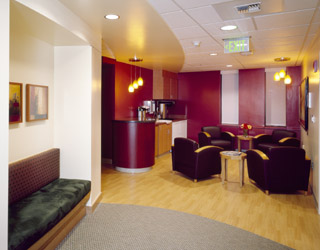
DJC.COM
April 24, 2008
Architects play key role on health care team
CollinsWoerman

Giuntoli
|
New advancements in patient treatment, health care delivery models and patient care have resulted in a deeper and different working relationship between health care institutions and architects.
Now more than ever, health care clients are asking their architectural teams to go beyond just designing spaces to fit existing needs and instead analyze how services can be delivered, and reengineer facilities that fulfill those services.
This trend has transformed the architect’s role in working with health care clients and the result has been better patient care.
It wasn’t always this way. In the not so distant past, health care clients simply developed a list of criteria based on their existing delivery models and asked for designs that incorporated those criteria. What came out of this process were functional, utilitarian spaces that perpetuated the status quo. But as health care changed, these spaces could not support the changing expectations of providers or patients.
One notable and ongoing change was the rapid, constantly evolving need for new technologies and delivery modalities. New communication devices and new high-tech equipment can change the nature of how space is designed. Similarly, patient-focused care reorders the priority of functional flows. And finally, the understanding that timely care is an important contributor to patient satisfaction defines operational standards that affect design.
A quicker recovery

Photo courtesy of Lara Swimmer Photography The traditional waiting room at Virginia Mason’s cancer center in Seattle has been replaced by a series of alcoves and seating areas, including a meditation room, education center and a cafe. |
The seeds of change in health care space design started about a decade ago when a series of influential studies demonstrated that patients tended to recover better in spaces that were well designed, featured ample amounts of natural light and instilled a sense of confidence.
Health care clients started to ask us for spaces that were both functional and aesthetically pleasing. This opened the door of communication and had the benefit of bringing architects to the table much earlier — not to just respond to criteria but be a part of creating the design criteria.
Confidence was the key. Health care providers are increasingly faced with two important considerations when building out new space: the growing demand for high-quality care and the rules of insurance reimbursement. Today, patients expect a much higher quality of care delivered in a timely manner and insist that this care is backed with first-rate facilities that, frankly, don’t look like your mom’s hospital room.
Patients now want, and expect, a seamless appearance of competence and expertise. True, these are emotional words, but architects, successful ones, understand how design and construction can deliver emotional responses.
This is vital for health care providers who are, in effect, competing for patients. Providers do not want to apologize for the appearance of their office: Things must be clean, there must be appropriate spaces, there must be an atmosphere that creates a positive response from the patient, and it must look appropriately professional.
Right from the start
Now, when I and my colleagues are invited to meet with a health care client, we come in at the very start, often before the client decides anything more than a new service is needed. And the conversations are not about designs at these early meetings — they are about processes, delivery systems, workflows, backend support and front-of-house presentation.
You truly get the feeling that this is how the architect-client relationship should be. We can be more effective when we have the most detailed information about how services are delivered. As part of this process, we constantly think about the patient’s experience. How many rooms does the patient need to travel to? What do the wait areas look like? Where are tests administered and samples delivered?
We have a chance to survey and interview current patients. Some of those surveys are direction on new designs. Many patients say they dislike being handed a form to fill out when they walk into an office. They find filling them out in public awkward, yet these forms are important to the physician.
Can we set up an infrastructure where the patient receives the forms electronically before they enter the office? What kind of technology can support that? These are clues about a new age of health care delivery.
Evergreen Hospital Medical Center in Kirkland recently asked us a simple question: Can you help us design a space where we can deliver comprehensive cancer treatment in a nurturing facility that houses three separate business entities? After walking through the treatment process wearing the shoes of a prospective patient, our answer was “yes.”
What was needed was a full review of how staff and patients move through a space, the location of their touch points for service and what do they need to feel as they are being treated. The space can easily feel like a single entity; it is the work processes and flows that will make it appear seamless.
Another client, Virginia Mason in Seattle, approached us with a need to create a more efficient design, a lean design that would improve patient care.
Again, our task was to work with their in-house team to fully review their processes for caring for patients. As many are aware, Virginia Mason is an early adopter of the “Toyota Way” and as such we participate in their early “3P” process analysis (production, preparation and process) that shapes new delivery models.
Through our joint review, it became apparent that patients don’t need, or want to see how the process works. They want to be comfortable, they want to have the process of their treatment explained, and they don’t want to travel from room to room for tests if it can be avoided.
These are design guidelines. They tell us to increase the opportunities for conversation, create inviting spaces that are welcoming and warm, and create, wherever possible, a system of mobile treatment where tests and treatment delivery can come to the patient.
A path to wellness
The goal of any health care provider is to keep their patients well or return them to a state of wellness. In the past, this was mostly accomplished through medical treatment. But as patient care has evolved, there has been an increasing realization that how the diagnosis is delivered, and how a patient experiences the process of receiving treatment is often as important as the treatment itself.
Providers have come to understand that how patients feel about their treatment is tied to their emotional well-being as they experience their treatment. If they are comfortable, confident and knowledgeable then their outcomes will be better. This emotional well-being can be influenced by designs that incorporate lessons from patient experiences and are both seamless and impressive to the patient.
By bringing architects into the design process at the very start, providers have created a truly mutual decision making process where both sides educate each other about what needs to be done. The result is a new age of health care facility design and a corresponding improvement in patient care.
Phil Giuntoli is the leader of CollinsWoerman’s health care sector work. He has 35 years of experience in programming, designing and managing complex medical and commercial projects.
Other Stories:
- Boomers lifting standards for patient care
- How BIM helped a hospital go green
- Time to improve hospital energy standards
- Boomers influence next generation of senior housing
- Innovative structures help hospitals cut costs
- For patients, silence is golden
Copyright ©2009 Seattle Daily Journal and DJC.COM.
Comments? Questions? Contact us.